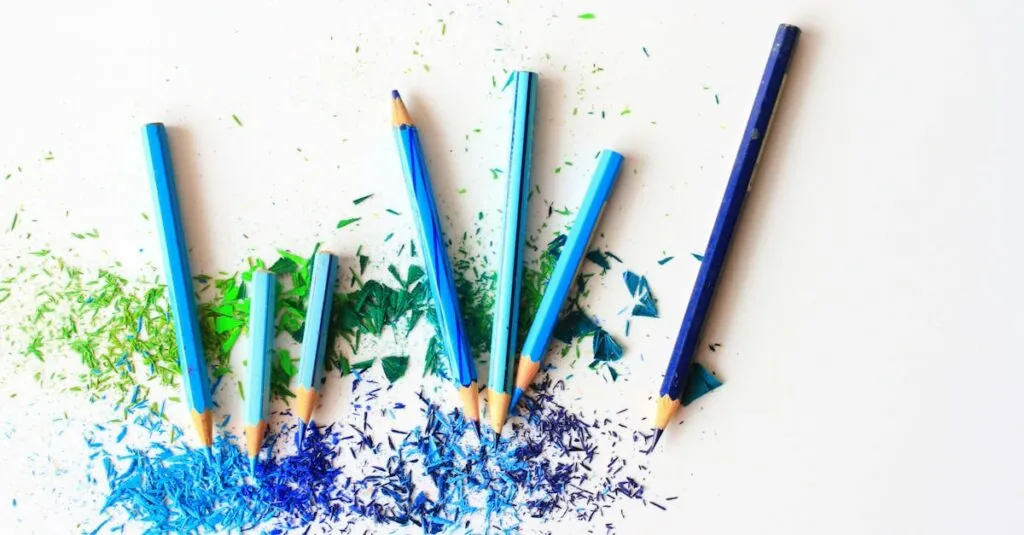Drawing isn’t just for the Picassos and Van Goghs of the world; it’s a skill anyone can master with a little practice and a dash of humor. Whether it’s doodling during a boring meeting or sketching your pet in a superhero cape, the joy of putting pencil to paper can be both hilarious and rewarding. Who knew that turning a stick figure into a masterpiece could spark such joy?
Table of Contents
ToggleUnderstanding The Basics Of Drawing
Drawing is an accessible skill that anyone can learn. It relies on understanding foundational techniques and developing a keen eye for detail.
Importance Of Observation
Observation plays a crucial role in drawing. Artists sharpen their skills by closely studying objects, enhancing their ability to capture shapes and proportions. Noticing light and shadow variations creates depth in artwork. Focusing on details, such as textures and colors, enriches the overall composition. This practice boosts creativity and allows for unique interpretations of everyday subjects. By observing the world around them, individuals gain insights that translate into improved drawing abilities.
Tools And Materials Needed
Selecting the right tools influences the drawing experience significantly. Pencils serve as versatile instruments, ranging from hard to soft leads for varying effects. Erasers, necessary for corrections, come in different types, each suited for specific materials. Sketchbooks offer a convenient surface for practice, allowing creators to experiment freely. Markers and pens, often used for inking, bring bold lines and precision to sketches. Exploring various papers can also enhance the artwork, as textures impact the final outcome. Investing in quality materials encourages consistent practice and growth.
Techniques For Beginners
Learning to draw involves mastering a few essential techniques. Beginners can develop their skills through practice and patience.
Sketching Fundamentals
Starting with basic shapes helps in understanding structure. Artists often use circles, squares, and triangles to lay a foundation for more complex drawings. Observing objects allows for accurate representation. Continuous line drawing enhances fluidity. Practicing quick sketches improves confidence. Using reference images aids in grasping proportions. Consistency in practice builds familiarity with tools. Each of these steps contributes to a solid drawing technique.
Shading And Texture
Creating depth and dimension requires effective shading techniques. Artists use hatching and cross-hatching to depict shadows. Different pencil pressures yield varying intensity, enhancing visual interest. Blending tools, such as tortillons, help smooth out transitions. Incorporating textures mimics surfaces like fabric or skin. Focusing on light source direction adds realism. Regular practice with shading leads to improved representation of three-dimensional forms. Exploring various techniques expands creative possibilities.
Advanced Drawing Techniques
Advanced drawing techniques offer artists the opportunity to elevate their skills and express their creativity in new ways. The following methods focus on expanding an artist’s abilities.
Perspective Drawing
Perspective drawing creates the illusion of depth on a flat surface. This technique involves understanding vanishing points and horizon lines. Artists begin by establishing a horizon line to define eye level. Drawing parallel lines toward the vanishing point helps depict distance accurately. One-point and two-point perspectives demonstrate basic concepts, offering a foundation for more complex compositions. Practicing landscapes and cityscapes strengthens the artist’s capacity to convey spatial relationships. Incorporating foreground and background elements enhances depth while guiding the viewer’s eye throughout the artwork.
Figure Drawing
Figure drawing focuses on capturing the human form in motion or stillness. Starting with quick gestures helps artists grasp proportions and essential shapes. Long poses allow for more detailed observation, emphasizing anatomy and body language. Artists should study muscle structure and skeletal frameworks, facilitating more accurate renderings. Drawing from life models or reference photos enriches understanding of movement and expression. Utilizing different materials, such as charcoal or ink, can create varied textures and enhance the overall impact. Continuous practice leads to improved accuracy and confidence in portraying figures effectively.
Common Mistakes To Avoid
Artists often encounter pitfalls during their drawing journey. Recognizing and avoiding common mistakes can enhance skills significantly.
Overworking Your Drawings
Overworking drawings leads to loss of freshness and spontaneity. Excessive detailing detracts from the overall impact, making art feel forced. An artist should embrace simplicity and clarity, as these qualities often resonate better with viewers. Taking breaks during the drawing process allows for a fresh perspective, potentially revealing areas needing refinement. Regularly stepping back to assess the work helps maintain balance between detail and composition.
Ignoring Proportions
Proportions play a crucial role in creating realistic illustrations. Neglecting them can result in distorted figures and awkward compositions. Artists must observe the relationships between different parts of the subject carefully. Using reference points or grid methods assists in aligning proportions accurately. Consistent practice with measuring techniques, such as sighting or using a pencil as a measuring tool, helps refine skills over time. Ensuring proportions remain consistent lays the foundation for more compelling, lifelike drawings.
Continuous Improvement In Drawing Skills
Improvement in drawing skills occurs through consistent practice and constructive feedback. Artists of all levels can enhance their abilities by following structured routines.
Practice Routines
Regular practice routines significantly boost drawing skills. Setting aside dedicated time each week fosters discipline. For instance, sketching for 30 minutes daily helps build muscle memory. Creating a varied routine, such as focusing on shapes one day and figures the next, adds diversity. Incorporating warm-up exercises, like quick sketches of everyday objects, can unlock creativity. Artists should also explore different styles and techniques to broaden their skillset and keep practice engaging.
Seeking Feedback
Feedback serves as a critical component in an artist’s growth. Sharing artwork with peers or mentors often leads to valuable insights. Constructive criticism helps identify areas for improvement. Joining local art groups or online communities allows artists to connect and exchange ideas. Engaging in workshops or classes creates opportunities for direct feedback from experienced instructors. Embracing both praise and critique fosters a balanced perspective, guiding artists toward specific enhancements in their work.
Drawing is a journey that anyone can embark on regardless of their starting point. With practice and the right mindset, individuals can unlock their creative potential and express themselves through art. Embracing the learning process and experimenting with various techniques will lead to growth and satisfaction.
Regular practice is key to mastering drawing skills. By dedicating time to sketch and seeking constructive feedback, artists can refine their abilities and build confidence. It’s essential to enjoy the process and celebrate small victories along the way. Drawing isn’t just about the final piece; it’s about the joy of creation and the exploration of one’s artistic voice.





